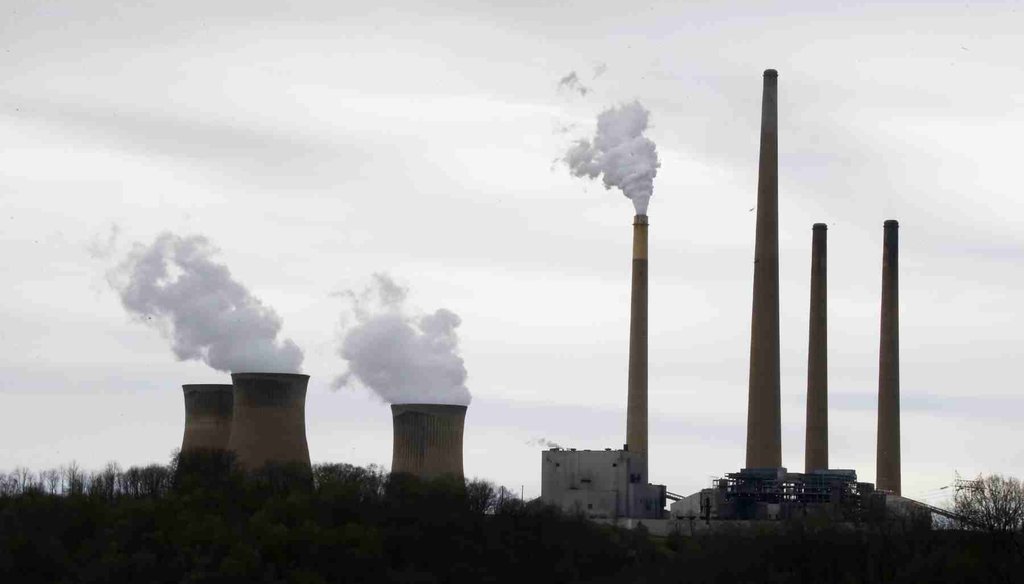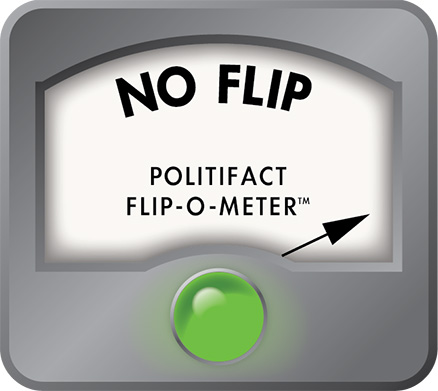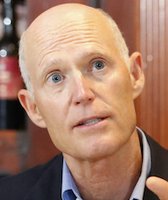Stand up for the facts!
Our only agenda is to publish the truth so you can be an informed participant in democracy.
We need your help.
I would like to contribute

Smokestacks of the Homer City Generating Station in Homer City, Pa., on May 5, 2014.
The Obama administration hasn’t even issued its planned regulations to curb carbon emissions yet, but that hasn’t stopped the U.S. Chamber of Commerce and the Environmental Protection Agency from engaging in a public spat over whether or how much the potential rules could harm the nation’s economy.
On June 2, 2014, President Barack Obama’s EPA is expected to unveil significant new regulations on existing coal and natural gas plants as part of the administration’s ongoing efforts to fight climate change.
The chamber — a leading pro-business group that has been consistently critical of Obama’s energy policies — preempted the administration's upcoming announcement by releasing a report that alleges new regulations on carbon emissions will cost the economy an average of $51 billion and 224,000 jobs each year through 2030. The report, released May 28, 2014, prompted a spate of ominous headlines from major news outlets.
The EPA shot back in a blog post that the chamber report is at best premature and at worst misleading, and said it's designed to stir controversy before the administration even makes its proposal. "I strongly suggest that folks read the proposal before they cry the sky is falling," EPA spokesman Tom Reynolds wrote in the blog.
What the dispute boils down to is whether natural gas power plants are eventually required to use an expensive technology known as carbon capture and storage.
Because the chamber’s claims hinge on predictions that will play out over more than a decade, we aren’t able to put the group’s claims to the Truth-O-Meter. But with a potentially far-reaching federal proposal in the offing, we thought it would be worthwhile taking a closer look at the chamber’s assertions.
How we got here
In 2007, the Supreme Court reaffirmed the EPA’s authority to regulate carbon dioxide as a pollutant under the Clean Air Act. Controlling the amount of carbon dioxide in the atmosphere is important because most scientists believe that it contributes to global warming.
In the absence of a Congress willing to regulate carbon dioxide, Obama in his second term has put curbing climate change near the top of his executive agenda.
Under Obama’s direction, the EPA in September 2013 released carbon standards for power plants built in the future. On June 2, it will do the same for existing facilities.
The regulations issued last September require new coal plants to emit no more than 1,100 pounds of carbon dioxide per megawatt-hour — a significant reduction. Meeting this standard would likely mean that future coal plants would have to use a technology called carbon capture and storage. As its name implies, this technology segregates carbon prior to being released into the atmosphere, then transports and stores the carbon in closed repositories, likely underground. The technology is new and expensive.
New natural gas plants, by contrast, would be less likely to need big investments in carbon capture and storage. They would have to keep emissions below 1,000 pounds of CO2 per megawatt hour — a level that’s considered feasible without carbon capture.
The New York Times and other outlets have leaked reports of what the EPA will say June 2 when it releases its regulations for existing plants, but we’ll hold off on speculating until we know for certain.
The chamber report
How did the chamber draw conclusions about the effects of regulations that aren’t fully released yet?
It turns out that the chamber made several assumptions that should be taken with a rock-sized grain of salt.
The chamber predicts that within the next decade, the administration will fail to remain on track to meet its 2030 carbon-reduction goals — and that it will begin requiring new natural gas plants to use carbon capture technology, a course those plants are not currently expected to have to undertake.
That's a big leap, and there are at least two reasons to be skeptical that it’s a good assumption.
First, let’s look at the goals that the chamber is basing its prediction on. The chamber says the administration wants to reduce carbon emissions by 42 percent by 2030, and by 80 percent before 2050. Obama did offer those benchmarks at the start of the Copenhagen climate change negotiations in 2009. However, those international talks ended with very little accomplished.
Obama has continued to support a carbon reduction of 80 percent by 2050, but has not stated a goal for 2030. More detailed benchmarks are expected in the June 2 announcement.
The chamber, by assuming the administration will require a significant drop in emissions by 2030, is making the bold prediction of a sharp departure in policy as early as 2022 (which, incidentally, will be long after Obama has left office). To do that, the chamber further assumes that the EPA will broaden its carbon capture technology requirement to new natural gas power plants.
This prediction makes for a very costly future. The chamber report estimates that requiring carbon capture technology on new natural gas plants "can more than double their construction costs and increases their total production cost by about 60 percent."
Using this assumption, the chamber estimates $478 billion in compliance costs to energy providers over the next 16 years. About $339 billion of those costs are related to power plant construction.
But if these assumptions don’t hold up, the figure would be a lot lower. The administration, for its part, says its misleading.
"If someone wants to put out a study about the hypothetical cost of requiring (carbon capture) for natural gas plants, they should say that’s what they’re doing," said White House spokesman Matthew Lehrich. "But they shouldn’t mislead people by pretending it’s a study about the upcoming EPA proposal."
We should note that its not entirely beyond the realm of possibility to think carbon capture will one day be the norm. In a recent Google hangout, Energy Secretary Ernest Moniz all but suggested that natural gas plants may some day need carbon capture to significantly reduce carbon emissions.
In calling natural gas a "bridge" energy, Moniz said, "Eventually, gas itself would need to be either phased out or have the CO2 captured if we are going to go to a very, very low-CO2 emission world," Moniz said.
Still, Moniz gave no timeframe for this, and he also spoke at length about new technologies that could significantly alter the energy landscape in the coming decades. This is a possibility the chamber analysis doesn’t take into account.
The chamber alos assumed that the administration’s June 2 announcement will closely mirror a proposal from the Natural Resources Defense Council, an environmental advocacy group that is often on the same page as the Obama administration. The NRDC has proposed setting a baseline carbon emissions level that each state would have to meet, while giving states a buffet of options to choose from to reach their goals.
The council proposal does have some similarities with what has been leaked about the coming EPA regulations. But if the proposed rules deviate at all, that could significantly alter the Chamber’s projections.
The bottom line
The chamber estimates that new regulations on carbon emissions will cost the economy $51 billion and 224,000 jobs each year through 2030.
We can’t say the chamber claim is right or wrong because it’s a prediction, and it’s certainly valid to estimate that curbing carbon emission will have an economic impact. But readers should know that the conclusions in this study are based on rules that haven’t been released yet and on a prediction that under a future president the EPA will require carbon capture for new natural gas plants. That is, to say the least, far from a certainty.
Our Sources
U.S. Chamber of Commerce, "Assessing the Impact of Potential New Carbon Regulations in the United States," May 28, 2014
U.S. Chamber of Commerce, "Double Whammy: EPA Carbon Regulations Will Mean Higher Electricity Costs, Fewer Jobs," May 28, 2014
Environmental Protection Agency, "Setting the Record Straight on the Chamber of Commerce’s Report," May 28, 2014
Email interview with Matt Lehrich, spokesman for the White House, May 28-30
Email and phone interview with Matt Letourneau, spokesman for the Institute for 21st Century Energy at the U.S. Chamber of Commerce, May 29-30
White House, President to Attend Copenhagen Climate Talks, Nov. 25, 2009
YouTube White House channel, Google+ Hangout: The State of Our Climate, May 19, 2014
Washington Post, "Everything you need to know about the EPA’s carbon limits for new power plants," Sept. 20, 2013
Environmental Protection Agency, "EPA Fact Sheet: Reducing Carbon Pollution From Power Plants," Sept. 2013
U.S. Supreme Court, Massachusetts v. Environmental Protection Agency, April 2, 2007
New York Times, "President Said to Be Planning to Use Executive Authority on Carbon Rule," May 28, 2014
Natural Resources Defense Council, "Cleaner and Cheaper: Using the Clean Air Act to Sharply Reduce Carbon Pollution from Existing Power Plants," 2014
Natural Resources Defense Council, "Closing the Power Plant Carbon Pollution Loophole," March 2013
























































